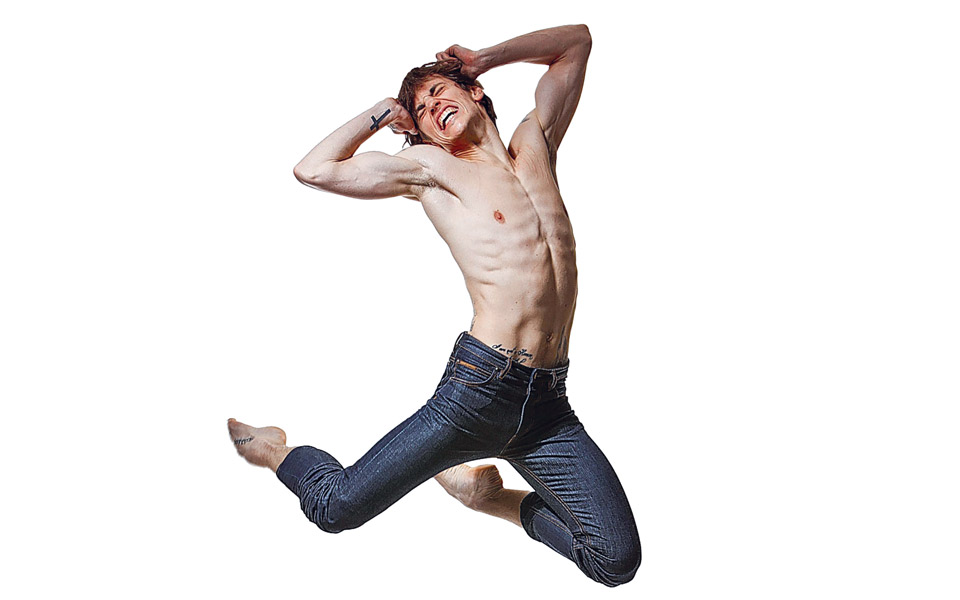Sergei Polunin, enfant terrible no more

“Dancers stare at themselves in the mirror almost all of the time,” celebrated Ukrainian dancer Sergei Polunin said at one point during the interview. “It helps us to improve,” he added.
A quick look in the mirror, highlighting a dancer’s mix of insecurity and confidence, is what audiences observe in the opening scenes of a documentary on the life of the 27-year-old award-winning dancer which opened in local cinemas recently, a few days ahead of Polunin’s appearance alongside acclaimed Russian ballerina Natalia Osipova at the Pallas Theater in Athens today through Saturday.
Steven Cantor’s “Dancer” traces Polunin’s journey of self-awareness from Ukraine to the Royal Ballet in London and his subsequent fall from glory – like a mirror reflecting himself. “It was a revelation for me, I learnt a lot about myself through this experience. It was a surprise, which I saw as positive right from the start,” he told Kathimerini.
His family had detected young Sergei’s talents early on and did everything in their power to help him toward a bright future through dance. At the age of 8 Polunin moved to Kiev, where he and his mother shared a room while he attended classes at the city’s State Choreographic Institute. At the same time his father moved to Portugal and his grandmother to Greece in order to work and cover his tuition fees. In 2003, sponsored by the Rudolf Nureyev Foundation, he moved to London to further his education at the Royal Ballet School. He did not speak English and trained endlessly to become a soloist. In 2010, at the age of 19, he was named the company’s youngest ever principal dancer. At the same time, as he recounts in the documentary, he was trying to reunite his family. Meanwhile, the rising ballet star was getting rave reviews, being compared to Nureyev and Nijinsky, and he was never out of the spotlight, until he threw it all away.
In 2012, Polunin shocked the ballet world by announcing his resignation from the Royal Ballet. Tweets and photos showed him attending wild parties, there were rumors of substance abuse, while comments he made regarding his desire to abandon dancing surfaced in the press. The “new Nureyev” soon turned into ballet’s “enfant terrible.” He was only 21 when his parents’ divorce in tandem with the psychological pressure of his career led him to run away from what he loved the most.
Polunin has now put those days behind him and, following a soul-searching period, no longer feels like the bad boy. “I’m not even sure what being a bad boy means. I’m fine and on good terms with myself,” he told Kathimerini. One of the determining factors that led him to return to his rightful place in the dance world – although he never really left – was his appearance in the music video for Irish singer-songwriter Hozier’s “Take Me to Church,” which went viral on YouTube.
“I never really left dance. Dancing is my way of being alive. When I left the Royal Ballet, however, the video became a reason for me to think and very clearly decide that my place is dancing on stage. Nowhere else, in no other field, could I ever be myself or feel so complete,” he said.
A year after Polunin abandoned the Royal Ballet, Osipova, a Bolshoi prima ballerina, left Russia to join the London dance company. The two dancers fell in love during rehearsals for a production of “Giselle” and have been dating since 2015. Being a couple both on and off stage is no easy task, according to the 27-year-old Ukrainian superstar dancer.
“At the beginning it was quite hard for me. Nevertheless, time helps to smooth out whatever differences there might be. We are two professional dancers with dynamic personalities who love each other and, most of all, dancing,” he noted.
At the Pallas Theater the artists will perform works by Russell Maliphant and Arthur Pita, while Osipova, accompanied by another two soloists, will also present a work by Sidi Larbi Cherkaoui.
“Each choreographer was unaware of what the other two were doing, they had no idea of the style adopted by their colleagues. So, while they should be treated separately by the audience, the works allow me to express myself in different ways. It’s a very refreshing procedure,” he noted.
When asked whether he preferred contemporary or classical dance, he responded: “I found things a lot easier in classical ballet. I have been dancing since childhood. When it comes to contemporary dance, I have to learn everything from scratch. I don’t think I have to decide whether I will go on with one or the other. I live every day as if it were unique and I take on the challenges.”
Pallas Theater, December 1-3





